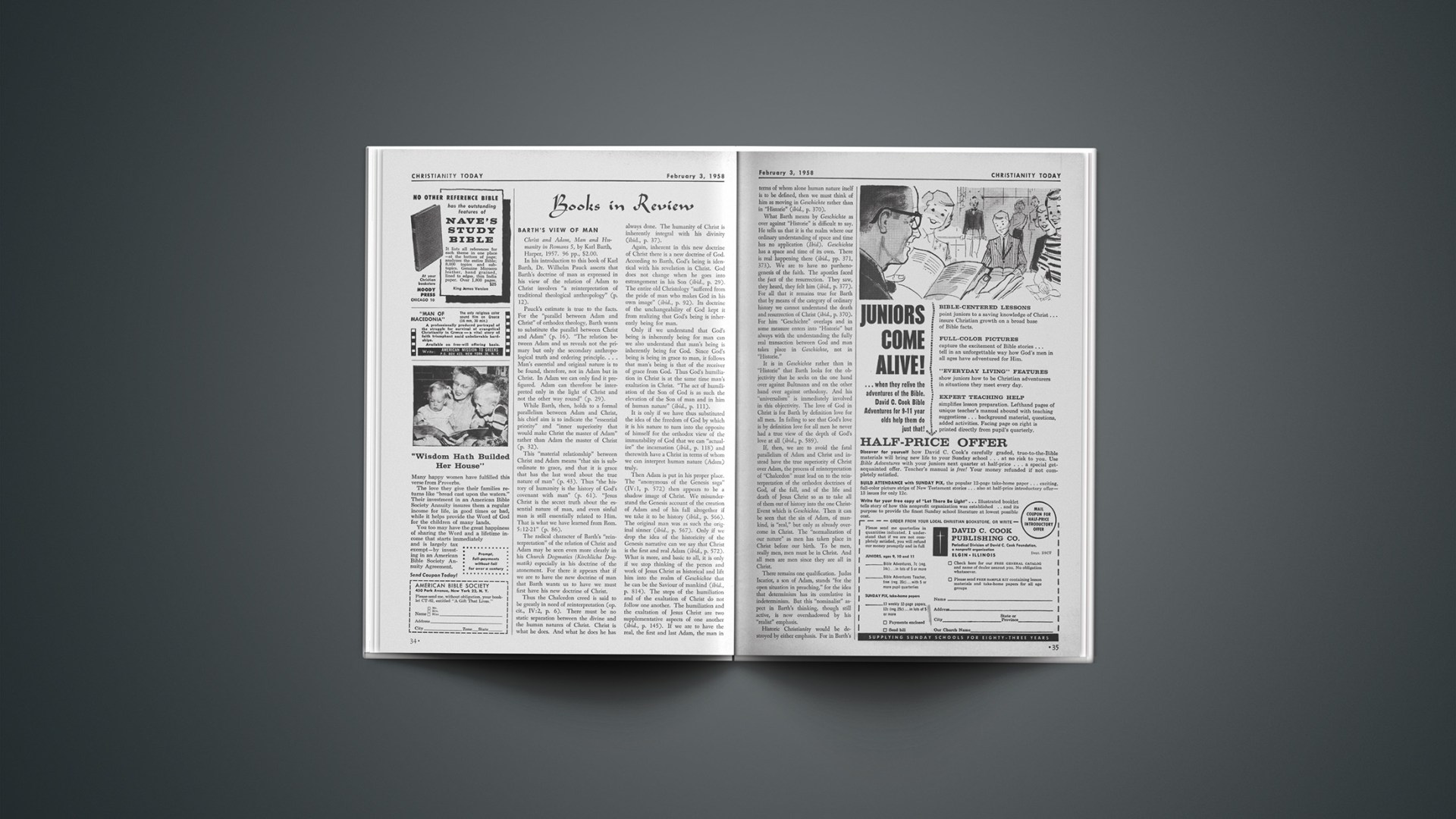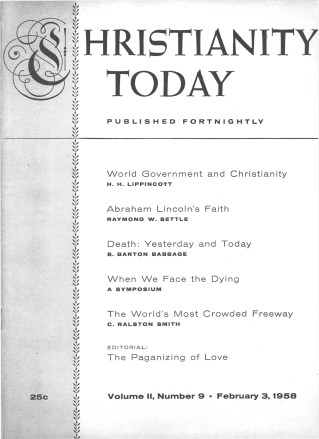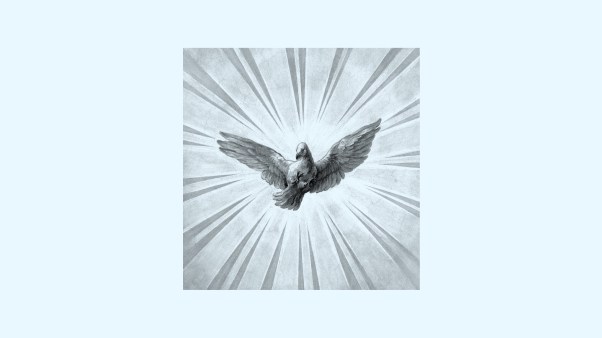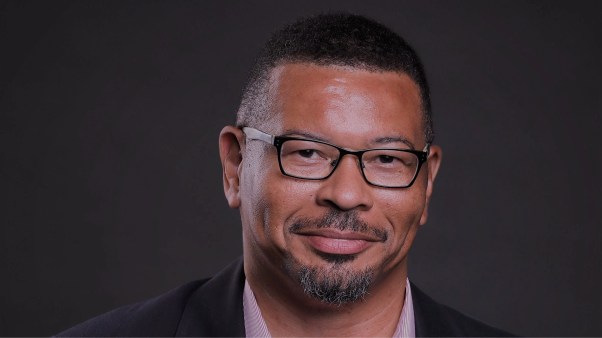Barth’s View Of Man
Christ and Adam, Man and Humanity in Romans 5, by Karl Barth, Harper, 1957. 96 pp., $2.00.
In his introduction to this book of Karl Barth, Dr. Wilhelm Pauck asserts that Barth’s doctrine of man as expressed in his view of the relation of Adam to Christ involves “a reinterpretation of traditional theological anthropology” (p. 12).
Pauck’s estimate is true to the facts. For the “parallel between Adam and Christ” of orthodox theology, Barth wants to substitute the parallel between Christ and Adam” (p. 16). “The relation between Adam and us reveals not the primary but only the secondary anthropological truth and ordering principle.… Man’s essential and original nature is to be found, therefore, not in Adam but in Christ. In Adam we can only find it prefigured. Adam can therefore be interpreted only in the light of Christ and not the other way round” (p. 29).
While Barth, then, holds to a formal parallelism between Adam and Christ, his chief aim is to indicate the “essential priority” and “inner superiority that would make Christ the master of Adam” rather than Adam the master of Christ (p. 32).
This “material relationship” between Christ and Adam means “that sin is subordinate to grace, and that it is grace that has the last word about the true nature of man” (p. 43). Thus “the history of humanity is the history of God’s covenant with man” (p. 61). “Jesus Christ is the secret truth about the essential nature of man, and even sinful man is still essentially related to Him. That is what we have learned from Rom. 5:12–21” (p. 86).
The radical character of Barth’s “reinterpretation” of the relation of Christ and Adam may be seen even more clearly in his Church Dogmatics (Kirchliche Dogmatik) especially in his doctrine of the atonement. For there it appears that if we are to have the new doctrine of man that Barth wants us to have we must first have his new doctrine of Christ.
Thus the Chalcedon creed is said to be greatly in need of reinterpretation Co. cit., IV:2, p. 6). There must be no static separation between the divine and the human natures of Christ. Christ is what he does. And what he does he has always done. The humanity of Christ is inherently integral with his divinity (ibid., p. 37).
Again, inherent in this new doctrine of Christ there is a new doctrine of God. According to Barth, God’s being is identical with his revelation in Christ. God does not change when he goes into estrangement in his Son (ibid., p. 29). The entire old Christology “suffered from the pride of man who makes God in his own image” (ibid., p. 92). Its doctrine of the unchangeability of God kept it from realizing that God’s being is inherently being for man.
Only if we understand that God’s being is inherently being for man can we also understand that man’s being is inherently being for God. Since God’s being is being in grace to man, it follows that man’s being is that of the receiver of grace from God. Thus God’s humiliation in Christ is at the same time man’s exaltation in Christ. “The act of humiliation of the Son of God is as such the elevation of the Son of man and in him of human nature” (ibid., p. 111).
It is only if we have thus substituted the idea of the freedom of God by which it is his nature to turn into the opposite of himself for the orthodox view of the immutability of God that we can “actualize” the incarnation (ibid., p. 118) and therewith have a Christ in terms of whom we can interpret human nature (Adam) truly.
Then Adam is put in his proper place. The “anonymous of the Genesis saga” (IV:1, p. 572) then appears to be a shadow image of Christ. We misunderstand the Genesis account of the creation of Adam and of his fall altogether if we take it to be history (ibid., p. 566). The original man was as such the original sinner (ibid., p. 567). Only if we drop the idea of the historicity of the Genesis narrative can we say that Christ is the first and real Adam (ibid., p. 572). What is more, and basic to all, it is only if we stop thinking of the person and work of Jesus Christ as historical and lift him into the realm of Geschichte that he can be the Saviour of mankind (ibid., p. 814). The steps of the humiliation and of the exaltation of Christ do not follow one another. The humiliation and the exaltation of Jesus Christ are two supplementative aspects of one another (ibid., p. 145). If we are to have the real, the first and last Adam, the man in terms of whom alone human nature itself is to be defined, then we must think of him as moving in Geschichte rather than in “Historie” (ibid., p. 370).
What Barth means by Geschichte as over against “Historie” is difficult to say. He tells us that it is the realm where our ordinary understanding of space and time has no application (Ibid). Geschichte has a space and time of its own. There is real happening there (ibid., pp. 371, 373). We are to have no parthenogenesis of the faith. The apostles faced the fact of the resurrection. They saw, they heard, they felt him (ibid., p. 377). For all that it remains true for Barth that by means of the category of ordinary history we cannot understand the death and resurrection of Christ (ibid., p. 370). For him “Geschichte” overlaps and in some measure enters into “Historie” but always with the understanding the fully real transaction between God and man takes place in Geschichte, not in “Historie.”
It is in Geschichte rather than in “Historie” that Barth looks for the objectivity that he seeks on the one hand over against Bultmann and on the other hand over against orthodoxy. And his “universalism” is immediately involved in this objectivity. The love of God in Christ is for Barth by definition love for all men. In failing to see that God’s love is by definition love for all men he never had a true view of the depth of God’s love at all (ibid., p. 589).
If, then, we are to avoid the fatal parallelism of Adam and Christ and instead have the true superiority of Christ over Adam, the process of reinterpretation of “Chalcedon” must lead on to the reinterpretation of the orthodox doctrines of God, of the fall, and of the life and death of Jesus Christ so as to take all of them out of history into the one Christ-Event which is Geschichte. Then it can be seen that the sin of Adam, of mankind, is “real,” but only as already overcome in Christ. The “normalization of our nature” as men has taken place in Christ before our birth. To be men, really men, men must be in Christ. And all men are men since they are all in Christ.
There remains one qualification. Judas Iscariot, a son of Adam, stands “for the open situation in preaching,” for the idea that determinism has its correlative in indeterminism. But this “nominalist” aspect in Barth’s thinking, though still active, is now overshadowed by his “realist” emphasis.
Historic Christianity would be destroyed by either emphasis. For in Barth’s view, God does not confront man in ordinary history. Man does not know and break the law and break it in history, and no atonement is made for him directly in history.
C. VAN TIL
Guidance In Building
Building The New Church, by William S. Clark, Religious Publishing Co., Jenkintown, Pa., 1957. $2.25 (paper $1.25).
When a new church is planned, the minister and building committee usually find themselves in need of guidance in their task. This little work is simply a handbook which will help to solve many of the problems they meet.
Every aspect of the building campaign is simply and succinctly dealt with in these pages. From “The Initial Preparation,” all the way through the process—the work of committees, meeting conflicting opinions in the congregation, choosing an architect, raising funds, materials of construction, art in the church, to “Dedication and Occupancy,” this book provides a guide.
The treatment is brief, perhaps too brief, but the bibliography points the way to further information. Like any other work on the subject, it serves to emphasize the fact that every minister should acquire a working knowledge of church architecture, to which this is but a short but highly useful introduction.
ARNOLD A. DALLIMORE
Scriptural Validity
Thy Word Is Truth, by Edward J. Young, Eerdmans, 1957. 287 pp., $3.50.
It is a pleasure to recommend this popular yet thorough book upholding the full truthfulness of the Bible. Dr. Edward J. Young knows the Bible and believes it. His other books on the Old Testament show his thorough familiarity with the critical attacks of our day. His defense is the more encouraging.
He develops a definition of inspiration-verbal inspiration—from the Scriptures themselves. He grounds the authority of the Word upon the inner testimony of the Holy Spirit. He also gives Christ’s attitude toward Scripture and shows that disbelief in it involves distrust of him.
In his section discussing inerrancy, he shows that this is the Church’s historic doctrine, and considers a number of the usually alleged inconsistencies, giving adequate answers to them. The reviewer would question the author’s treatment of the details of some of these problem passages, but in any case Dr. Young has established his main thesis that the Bible in these places has no insoluble difficulty.
The last part of the book is somewhat different. In Chapter 8 he adopts, largely, the apologetical viewpoint of Van Til. He accepts the charge that Bible believers reason in a circle (p. 192), and says that “If one begins with the presuppositions of unbelief, he will end with unbelief’s conclusions” (p. 191). The reviewer would like to differ with the author here. The fact is that the apostles did not forbear to argue nor did they use circular reasoning. They appealed to facts of observation declaring that these should convince the doubting, and doubters were saved by the thousands. They established the validity of the claims of Christ by a witness to historical facts. After that, the authority of Christ was sufficient for all matters. This is not circular reasoning; it is reliance upon valid historical testimony. And it has been used to convince doubters down through the ages. Numerous famous men have begun to write books against the Bible using wrong presuppositions only to have the redemptive facts used of the Spirit to convert them and cause them to change their views. We should add, however, that this chapter is an able and readable statement of the author’s position.
The last section is a much needed analysis of some modern denials of the Bible. The ideas concerning Scripture of O. Piper, G. Ernest Wright and John Mackay of this country, Alan Richardson and H. L. Ellison of England, and Brunner and Barth of the Continent are briefly but effectively analyzed and shown to be quite erroneous. This section is enough to commend the book to orthodox readers. The reviewer hopes that it will be widely used and that many may profit from it.
R. LAIRD HARRIS
Heritage Piece
One Hundred Years in the New World, issued by the Centennial Committee of the Christian Reformed Church, Grand Rapids, Michigan, 1957. 218 pages, $3.95.
The year-long program of activities marking the denominational centennial of the Christian Reformed Church in 1957 has occasioned a great deal of favorable comment from many quarters. Built around goals of church extension and increased laymen’s participation, perhaps the greatest impact was made through the vigorous use of the printed page, including an integrated program of newspaper ads and articles, historical and informational booklets, church bulletins and a variety of other publications.
To this has now been added the official memorial volume, One Hundred Years in the New World, which depicts in a series of articles the history of the denomination from its formation by a group of Dutch immigrants a century ago, as well as various aspects of the church’s work in the fields of education, home missions, neighborhood evangelism, Indian and foreign missions, youth work, the ministry of mercy, and publications. Embellished with more than 300 well-chosen photographs, the volume is a most attractive pictorial memento of the denomination’s centennial celebration and a heritage piece that will undoubtedly be treasured among Christian Reformed families for years to come. It is also a good example of the use of the printed page to help instill denominational loyalty and, especially in young people, an appreciation of their historical background.
J. MARCELLUS KIK
The Garden Story
Billy Graham and the New York Crusade, by George Burnham and Lee Fisher, Zondervan, 1957. $2.50.
An experienced journalist has the perspicuity in observing the facts to sift the irrelevant from the important; and also has the perspective to realize the significance of the facts. In excellent journalistic style George Burnham and Lee Fisher tell the story of Manhattan’s 1957 miracle.
There is understanding of Billy Graham’s background so as to show his sincerity, humility, and utter devotion to the Saviour and to the Scriptures. One receives insight into the faith and courage of young men who accepted the challenge of the apparently impossible—summer-time evangelistic services in Madison Square Garden!
From these pages one gets vivid impression of the setting for the services—a huge sports arena transformed into a house of God by the presence of the Holy Spirit. The Gospel of saving grace was preached in simplicity and earnestness, and the response was overwhelming. The testimonies of some who received Christ are graphically told by way of illustration of the power of the Gospel to save the up and out and the down and out.
In these pages one relives the high tide of Spirit-filled evangelism in the Garden, at Yankee Stadium, on Wall Street, or on Times Square. To those who could not attend, or who saw the telecast on Saturday evenings, this is a thrilling account of what actually took place.
V. R. EDMAN










